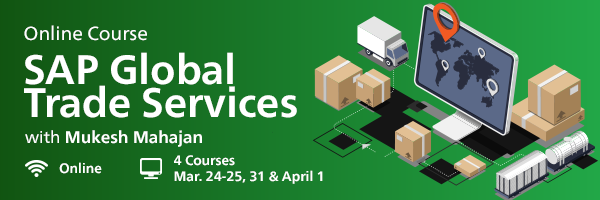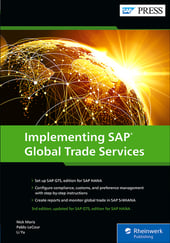In today’s rapidly evolving global trade landscape, businesses face increasingly complex regulatory requirements and heightened demand for operational efficiency.
To meet these challenges head-on, many organizations turn to SAP Global Trade Services (SAP GTS), a comprehensive solution designed to streamline and automate trade processes while ensuring compliance with international regulations. However, as technology advances and business needs change, it becomes imperative for companies to stay up to date with the latest innovations in SAP GTS.
One such innovation is SAP GTS, edition for SAP HANA, a cutting-edge solution built on the SAP HANA platform. In this blog post, we’ll delve into the motivating features behind upgrading to SAP GTS, edition for SAP HANA and guide you through the process of preparing for your migration.
Features of SAP GTS, Edition for SAP HANA
There are several key drivers for upgrading to the latest version of SAP GTS. Let’s walk through them.
Harnessing the Power of SAP HANA Technology
SAP GTS, edition for SAP HANA leverages the advanced capabilities of the SAP HANA platform, renowned for its in-memory data retention capabilities. This innovation not only enhances operational efficiency but also lays the groundwork for a superior user experience and enables new avenues for innovation. By embracing SAP HANA technology, businesses can unlock insights from their data and accelerate decision-making processes. Additionally, SAP GTS, edition for SAP HANA integrates with SAP S/4HANA and SAP ERP, as well as various non-SAP applications, ensuring compatibility and interoperability across your entire system landscape.
Elevated User Experience with SAP Fiori
SAP GTS, edition for SAP HANA delivers a revamped user interface through SAP Fiori. This intuitive interface enhances usability and efficiency, allowing users to navigate seamlessly through the system via the SAP Fiori launchpad. While transitioning to SAP Fiori may require some change management efforts, the overall user experience is significantly improved, driving productivity and user satisfaction.
Sustainable Long-Term Solution
Perhaps the most compelling reason to migrate to SAP GTS, edition for SAP HANA is that the existing SAP GTS 11.0 version is nearing the end of its lifecycle. By the end of December 2025, SAP GTS 11.0 will no longer receive mainstream maintenance and support, making it imperative for businesses to upgrade to the latest edition. Furthermore, with SAP GTS, edition for SAP HANA, updates and enhancements will be aligned with the release schedule of the SAP HANA platform, ensuring continuous improvement and compliance with evolving regulatory requirements.
Keeping Up with Trade Regulatory Changes
In today’s dynamic global trade environment, staying compliant with regulatory changes is a constant challenge. SAP GTS, edition for SAP HANA addresses this challenge by providing timely updates and SAP Notes to adapt the product to follow regulatory changes in localized markets. This proactive approach enables businesses to stay ahead of regulatory requirements and minimize compliance risks.
SAP GTS, Edition for SAP HANA Migration Process
Now that we’ve explored the drivers for upgrading to SAP GTS, edition for SAP HANA, let’s dive into the migration process and key considerations for a successful transition.
Upgrade Process: Planning and Preparation
The upgrade process begins with thorough planning and preparation to ensure a smooth migration. Key tools such as the SAP Readiness Check, simplification list, and maintenance planner play a crucial role in assessing system readiness, identifying potential compatibility issues, and planning the migration roadmap. By leveraging these tools effectively, businesses can mitigate risks and streamline the upgrade process.
Upgrade Process: Realization Phase
Once the planning phase is complete, it’s time to execute the migration using the Software Update Manager (SUM). SUM facilitates the entire conversion process, including system validation, data migration, software updates, and data conversion. By following a structured approach and adhering to best practices, businesses can minimize downtime and ensure a successful migration to SAP GTS, edition for SAP HANA.
Choosing the Right Migration Strategy
When it comes to migration strategies, businesses can opt for either a brownfield or greenfield approach. Each approach has its pros and cons, depending on factors such as system complexity, customization requirements, and organizational readiness. By carefully evaluating these factors, businesses can choose the strategy that best aligns with their goals and constraints.
Prerequisites and System Requirements
Before commencing the migration, it’s essential to ensure that all prerequisites and system requirements are met. This includes verifying hardware and software compatibility, performing system checks, and preparing backup procedures. By meticulously addressing these prerequisites, businesses can minimize disruptions and ensure a seamless migration process.
About the Implementing SAP Global Trade Services Book
As the end of maintenance for SAP GTS 11.0 approaches, now is the time to embark on your migration journey and embrace the future of trade management with SAP GTS, edition for SAP HANA. Our updated guide on SAP GTS will help you navigate your implementation and make the most of the latest capabilities.
The introduction explores the fundamentals of global trade management, including compliance, customs, and preference management. You’ll learn about SAP's role in global trade management, get an overview of SAP GTS, edition for SAP HANA, and compare the solution to SAP S/4HANA for international trade.
Moving on to SAP GTS setup, authorizations, and navigation, you'll understand how to connect SAP GTS, edition for SAP HANA to feeder systems like SAP S/4HANA. This includes system architecture, configuration, and interfacing techniques, along with navigation through SAP GTS using the SAP Fiori launchpad.
Discover the organizational structure in SAP GTS, such as foreign trade organizations, legal units, administrative units, and customs IDs. You’ll also learn about plug-in settings in SAP S/4HANA and general settings in SAP GTS, including legal regulations, document types, and mapping.
See how to manage your master data, starting with the initial data transfer from the feeder system to SAP GTS. Walk through master data for business partners, products, bills of materials, licenses and authorizations, and more. Then learn about uploading classification codes, classifying for Compliance Management and Customs Management, reclassifying products, and configuring classification settings.
The Compliance Management chapter covers customs documents, sanctioned party list (SPL) screening, embargo management, legal control, import and export licensing, and US re-export, along with configuration and master data management. Moving on to the Customs Management functionality, you’ll explore customs declarations, import and export processes, special customs procedures, excise duty monitoring, US reconciliation, electronic communication, and associated configuration and master data.
Next, dive into new-and-improved Preference Management capabilities. See how to obtain and determine preferential status, issue certificates of origin, manage supplier declarations, evaluate preference results, and more—then configure your settings and manage master data.
In the global trade reporting chapter, explore SAP Fiori-based reporting, embedded analytics, and analytical reporting using SAP BW/4HANA, SAP Datasphere, and SAP HANA for SQL data warehousing.
Prepare for your migration by understanding the drivers for transitioning to SAP GTS, edition for SAP HANA, the upgrade process, and the simplification list. Finally, get insights into the future of SAP GTS, including planned innovations and the road ahead.
Who Is This Book For?
This book is aimed toward logistics consultants and implementation team members who want to learn how to set up and configure SAP GTS, edition for SAP HANA. Functional and business analysts, especially from compliance and risk management, will also find this book beneficial.
About the Authors
Nick Moris is a partner at Deloitte’s consulting practice and part of the global leadership of Deloitte’s SAP GTS center of excellence. He focuses on support and advice regarding global trade solutions. He has built up a lot of expertise within SAP (including SAP GTS and SAP S/4HANA for international trade) and, with his team, supports several multinationals in the setup of international trade processes in ERP.
Pablo LeCour is a principal at Deloitte’s Global Trade Advisory (GTA) practice in the USA with more than 23 years of experience in regulatory compliance. His focus is on export controls, sanctions, customs, and anti-bribery/anti-corruption (ABAC). Pablo leads the Global Trade Technology practice in the Americas, where he oversees global trade compliance transformation initiatives. Prior to joining Deloitte’s US GTA practice, Pablo led the Regulatory Risk practice for Deloitte Advisory in the UK.
Li Yu is specialist leader within Deloitte’s SAP GTS center of excellence. She has more than 25 years of experience in SAP ERP implementation with a particular focus on SAP GTS implementation. Li has worked with clients globally, including the Asia-Pacific (APAC), Europe, and North America regions. Her expertise includes delivering large-scale global projects that are customized to fulfill business needs and regulatory requirements while applying leading practice methodologies.
How to Purchase
If you’re interested in purchasing Implementing SAP Global Trade Services, follow this link and choose the format that works best for you: e-book, print edition, or bundle (both e-book and print).
If you want to continue learning about SAP GTS, or if you want information on other upcoming books or special offers, make sure to sign up for our topic newsletters or our weekly blog recap.
Learn SAP GTS in Our Upcoming Rheinwerk Course!
Navigate volatile global supply chains with SAP GTS, edition for SAP HANA! Learn its architecture and configuration and dive into customs, compliance, and preference management to cover your global operations. Click on the banner below to learn more and order your ticket.




Comments